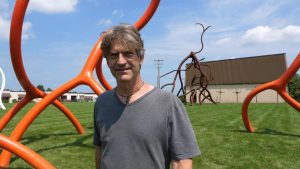Steve Tobin: At Home Going Big
Description
Some people live to push against the edge of possibility. The sculptor Steve Tobin revels in it.
Featured Artists

Steve Tobin is an innovative sculptor known for his large-scale artwork inspired by the natural world.
Tobin was born in Philadelphia in 1957. He had his first solo exhibition in 1979, the year he graduated from Tulane University with a BS in theoretical mathematics. He constructed his early artwork in glass, including seven-foot-tall blown-glass cocoons hung in a chapel in Antwerp and a towering waterfall of shards at Retretti Art Centre in Finland. He moved away from glass sculpture in the early 1990s, mortgaging his house to travel to Ghana to make casts of termite mounds that were displayed at Fuller Museum of Art in Massachusetts.
Tobin’s best-known recent artworks are large-scale representations of tree roots. In 2005, he cast an above-ground bronze replica of the root system and stump of a tree that prevented damage to a nearby church during the September 11 attacks. He has had exhibits of his massive steel root sculptures at museums and botanical gardens across North America and in China.
Transcript
Steve Tobin isn’t afraid to go big.
Steve Tobin: I don’t mind gambling everything on the next piece. At one point, I mortgaged my house to go to Ghana, to make molds of the termite hills, because I wanted to bring them to New York, and juxtapose insect architecture with human architecture, and show the power and sophistication of nature.
Indeed, the ideas that seem most outlandish are usually the ones Tobin pursues. In the early 90s, he set out to make blown glass sculptures seven-feet-tall—despite the fact that this was suppose to be beyond the physical limits of the material.
Tobin: Eventually I did it 15-feet-high, but the scientists at Corning said that the strength of glass would not support itself at that size in the production process. And, in fact, that was quite true. The first 300 pieces I made broke exactly when they said and where they said. But I had built a 22-foot-high building, and ovens 15-feet-long, so I had to make it work. And I found a way around the problem. In terms of the physics or science behind it, glass has a skin, and the strength of the skin would not be strong enough to support the forces on it at that small neck, given the length of the pieces I made. So I took the skin away by keeping the skin liquid. So there was no surface to break—which is really an elegant solution in science, is, if you have a big problem, don’t confront the problem. Find a way to digest the problem into to smaller issues.
AJC: That sounds more like an artist than a scientist.
Tobin: I think that scientists, in many ways, are more creative than artists, because they start with nothing, and they have to define the whole universe. And the difference is they have to make it work, whereas an artist only has to make it work within their own set of rules.
AJC: And beyond the amount of intellect that goes into this, how often are the finished objects a representation of you emotionally, or is that even on the agenda?
Tobin: That’s the most important side. It’s not what I make, but why. And I think that what I do is more rooted in philosophy, and I use process to express it, hopefully in a magical way.
And in some cases that magic has been overwhelming. In the case of Cocoons, shown here in a chapel in Antwerp, Belgium, Tobin says that achievement marked the end of an era for him.
Tobin: That piece transcended any of my ambitions as an artist. It was better than I was. It was something about the context that animated the work. And, after that, I retired from blowing glass because I felt that…
AJC: You’d exceeded your ambitions?
Tobin: Yes.
From there, Tobin began experimenting with scrap glass, creating temporary installations of 40-foot-tall sculptures and 100-foot-long rivers. But it wasn’t long before his career took a hard left turn.
Tobin: So after I did the glass rivers, and I did the cast glass, I felt that I was done with the material. That, by sticking with the material, then the material is dictating the aesthetic too much, and the characteristics and the process associated with it. I felt that, to understand myself, what I was doing, I had to leave the material. My work is not about refining. It’s more about developing ideas and seeing them progress.
From there, Tobin went on to test the limits of his imagination once again—first in bronze, then steel, exploded clay, and, most recently, in wood. But more important than the everchanging how is Tobin’s persistent why.
Tobin: I know how something needs to be made. I know how it’s going to look. Why make it? I don’t know how it’s going to feel. And if I don’t know it’s going to feel, then that’s my biggest motivation to make something.
AJC: And you stand back and you say?
Tobin: Who made this? That’s the result. “Who made this?” It wasn’t me. It wasn’t my assistants. It wasn’t the curator. Who made this?
Steve Tobin believes he is making art for the ages—art made not to represent himself or the time he’s living in, but a universally human narrative.

